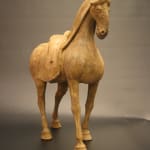Early Tang Painted Pottery Horse, 618 CE - 907 CE
Terra Cotta
78 x 39.9 cm
30 3/4 x 15 3/4 in
30 3/4 x 15 3/4 in
DL.2089
The great influence of the horse throughout the history of China cannot be underestimated. In fact, the ancient unification of the Chinese Empire was due in large part to the...
The great influence of the horse throughout the history of China cannot be underestimated. In fact, the ancient unification of the Chinese Empire was due in large part to the horse. Their rapid mobility allowed for quick communication between far away provinces. Likewise, the military role of horses aided in the conquest and submission of distant lands. The need to import stronger, faster steeds from Central Asia (as opposed to the native Mongol pony) led to the creation of the Silk Road. The importance of the horse in the history and culture of China can be viewed, in part, through the artistic legacy of this great civilization. In sculpture, painting, and literature, horses were glorified and revered, believed to be relatives of dragons, a theory reflecting their sacred status within society. During the Tang Dynasty, the adoration of the horse can be seen through their burial art. Horse models excavated from mausoleums of the period are among the most splendid and easily recognizable works of Chinese art.
This elegant, painted horse is no exception. The downward curve of the face echoes that of the splendid mane. It is easy to imagine this fine steed galloping across the horizon, en route to some distant province to deliver an official message with its glorious red saddle. Alternatively, it may have been the treasured possession of a noble aristocrat who partook in polo matches. Surely this horse, crafted with loving care and attention to detail, was admired as much in life as it is in its sculptural form.
This elegant, painted horse is no exception. The downward curve of the face echoes that of the splendid mane. It is easy to imagine this fine steed galloping across the horizon, en route to some distant province to deliver an official message with its glorious red saddle. Alternatively, it may have been the treasured possession of a noble aristocrat who partook in polo matches. Surely this horse, crafted with loving care and attention to detail, was admired as much in life as it is in its sculptural form.



